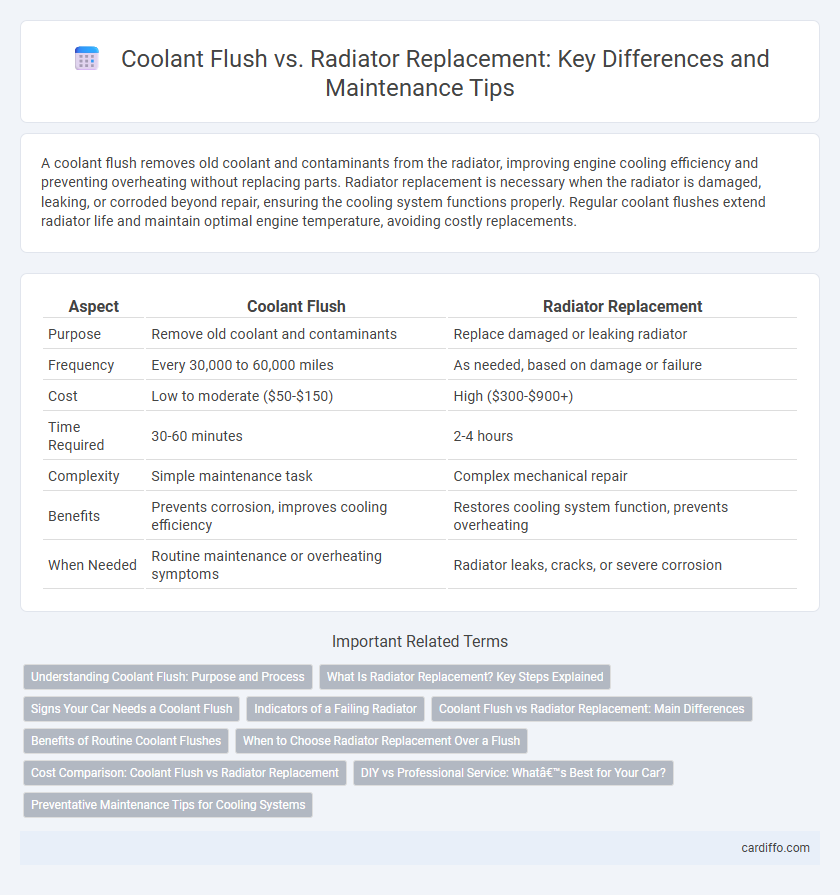A coolant flush removes old coolant and contaminants from the radiator, improving engine cooling efficiency and preventing overheating without replacing parts. Radiator replacement is necessary when the radiator is damaged, leaking, or corroded beyond repair, ensuring the cooling system functions properly. Regular coolant flushes extend radiator life and maintain optimal engine temperature, avoiding costly replacements.
Table of Comparison
| Aspect | Coolant Flush | Radiator Replacement |
|---|---|---|
| Purpose | Remove old coolant and contaminants | Replace damaged or leaking radiator |
| Frequency | Every 30,000 to 60,000 miles | As needed, based on damage or failure |
| Cost | Low to moderate ($50-$150) | High ($300-$900+) |
| Time Required | 30-60 minutes | 2-4 hours |
| Complexity | Simple maintenance task | Complex mechanical repair |
| Benefits | Prevents corrosion, improves cooling efficiency | Restores cooling system function, prevents overheating |
| When Needed | Routine maintenance or overheating symptoms | Radiator leaks, cracks, or severe corrosion |
Understanding Coolant Flush: Purpose and Process
A coolant flush removes old coolant and contaminants from the radiator and cooling system to maintain optimal engine temperature and prevent corrosion or buildup. This process involves draining the existing coolant, flushing the system with clean water or a specialized solution, and refilling it with fresh coolant to ensure efficient heat transfer. Regular coolant flushes extend radiator life and improve engine performance by preventing overheating and damage.
What Is Radiator Replacement? Key Steps Explained
Radiator replacement involves removing the old, damaged radiator and installing a new one to restore efficient engine cooling. Key steps include draining the coolant, disconnecting the radiator hoses and transmission cooler lines, removing mounting brackets, and carefully extracting the radiator. After installing the new radiator, technicians reconnect all hoses, refill the coolant system, and perform pressure tests to ensure there are no leaks and optimal cooling performance.
Signs Your Car Needs a Coolant Flush
Signs your car needs a coolant flush include overheating engine temperatures, coolant discoloration or sludge build-up, and persistent radiator leaks. A coolant flush removes contaminants and old fluid that degrade cooling system efficiency, preventing corrosion and maintaining optimum engine performance. Ignoring these signs can lead to radiator failure, which may necessitate a costly radiator replacement.
Indicators of a Failing Radiator
Indicators of a failing radiator include frequent overheating, visible coolant leaks, and rust or discoloration around the radiator surface. Coolant flushes can temporarily improve system performance, but extensive corrosion or physical damage often necessitates radiator replacement for long-term reliability. Monitoring temperature gauge fluctuations and unusual engine smells can help detect internal blockages or compromised radiator integrity early.
Coolant Flush vs Radiator Replacement: Main Differences
Coolant flush involves draining and refilling the radiator with fresh coolant to remove contaminants and improve engine temperature regulation, while radiator replacement entails installing a new radiator to resolve severe leaks or physical damage. A coolant flush is a routine maintenance task typically recommended every 30,000 to 50,000 miles, whereas radiator replacement is necessary when the radiator is cracked, corroded, or beyond repair. Understanding these differences helps prevent overheating issues and extends the vehicle's cooling system lifespan.
Benefits of Routine Coolant Flushes
Routine coolant flushes improve engine performance by removing rust, scale, and debris that accumulate in the cooling system, preventing overheating and corrosion. Regular flushing extends radiator life by maintaining optimal coolant quality, reducing the risk of costly radiator replacements caused by blockages or leaks. Maintaining proper coolant levels and composition enhances heat transfer efficiency, promoting long-term engine reliability and fuel efficiency.
When to Choose Radiator Replacement Over a Flush
Radiator replacement is necessary when the radiator has significant leaks, corrosion, or physical damage that a coolant flush cannot fix. Persistent overheating, visible cracks, or coolant contamination indicate the radiator's inability to function properly, making replacement a more effective long-term solution. Coolant flushes are suitable for routine maintenance, but severe radiator failures require replacement to ensure optimal engine cooling performance.
Cost Comparison: Coolant Flush vs Radiator Replacement
A coolant flush typically costs between $100 and $150, offering an affordable routine maintenance option that extends radiator life and prevents overheating. Radiator replacement, on the other hand, ranges from $500 to $1,000 or more due to parts and labor, making it a more expensive solution reserved for severe damage or leaks. Choosing a coolant flush regularly can reduce the likelihood of costly radiator replacements by maintaining optimal cooling system performance.
DIY vs Professional Service: What’s Best for Your Car?
Performing a coolant flush at home can effectively remove contaminants and maintain optimal engine temperature, requiring basic tools and moderate mechanical knowledge, making it a suitable DIY task for many car owners. Radiator replacement, however, involves complex steps such as draining the system, disconnecting hoses, mounting the new radiator, and refilling coolant, which often necessitates professional expertise to avoid leaks and ensure proper installation. Choosing between DIY coolant flush and professional radiator replacement depends on your skill level, the specific car model, and whether the radiator itself is damaged or just the coolant needs refreshing.
Preventative Maintenance Tips for Cooling Systems
Regular coolant flushes every 30,000 to 50,000 miles help prevent corrosion, overheating, and buildup in the cooling system, extending radiator life. Replacing the radiator is necessary only when leaks, cracks, or severe blockages occur that compromise cooling efficiency. Maintaining proper coolant levels and performing routine inspections of hoses and clamps optimize system performance and prevent costly repairs.
Coolant flush vs radiator replacement Infographic

 cardiffo.com
cardiffo.com